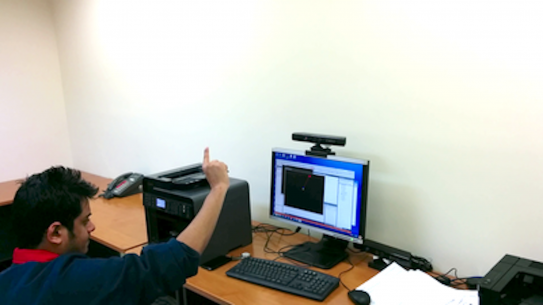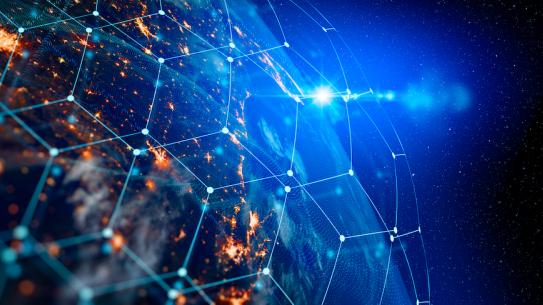Data Science / AI / Robotics
Three disciplines come together to create the technologies that will define the future.
Our AI experts and roboticists are working in concert with our data scientists, who are discovering new ways to analyze, visualize, and use their skills for a common goal: to harness the collective power of data, machine learning techniques, and autonomous systems to address the issues facing the world.

AI is everywhere. Can we make sure it's ethical?
AI powers so much of our world. It’s used by recruiters, police departments and businesses to help make their work more efficient. But with people’s lives on the line, can we trust that the algorithms behind AI are being created fairly? NYU Tandon researchers are helping to create an ecosystem where AI is critically analyzed to minimize the bias behind the code, and to ensure that these systems are used fairly and equitably whenever possible.

Better robotics through better data
At NYU Tandon, researchers are using 5G to connect autonomous teams of robots to complete tough and dangerous jobs, mimicking complex animal behaviors in remotely controlled robots, and creating cheaper, more accessible robots so that anyone can learn to program the next advancement in robotics. The future is here, and it’s being developed by our engineers.

Ludovic Righetti
Associate Professor Ludovic Righetti leads the Machines in Motion Laboratory, where he is exploring the algorithmic principles that allow a robot to run through rocky terrain, lift a couch while reaching for an object that rolled under it, or manipulate a screwdriver while balancing on top of a ladder. His aim is to create robots with the robustness and adaptability necessary to efficiently and autonomously act in an unknown and changing environment.

Giuseppe Loianno
Assistant Professor Giuseppe Loianno heads NYU Tandon’s Agile Robotics and Perception Lab (ARPL), where his research involves creating agile autonomous machines that can navigate all by themselves using only onboard sensors in unstructured and dynamically changing environments — and without relying on external infrastructure, such as GPS or motion capture systems. Whether it’s a small-scale aerial vehicle that can autonomously inspect the interior of a nuclear power plant or a resilient, cognitive, heterogeneous swarm of drones capable of search and rescue missions or humanitarian aid, they’re working on it at ARPL.
Responsible AI and Why it Matters
AI is becoming more and more prevalent in businesses, public services, and other parts of our lives. But when the algorithms behind AI are written with the same prejudices that marr our current society, it has the potential to deepen inequality, not overcome it. In this webinar, members of The Center for Responsible AI walk us through their perspectives on the use of AI and automation, and their recommendations to make sure responsible AI will be the only kind of AI used in the future in this seminar.
Research Labs and Groups

Agile Robotics and Perception Lab
ARPL performs fundamental and applied research in robot autonomy. The lab develops agile autonomous drones that can navigate on their own using only onboard sensors without relying on maps, GPS or motion capture systems.

AI4CE Lab
The AI4CE Lab works to advance fundamental automation and intelligence technologies, to enable their use in civil and mechanical engineering applications.

Algorithms and Foundations Group
The Algorithms and Foundations Group at NYU's Tandon School of Engineering is composed of researchers interested in applying mathematical and theoretical tools to a variety of disciplines in computer science. We study problems in machine learning, geometry, computational biology, computational mathematics, and beyond.

Applied Dynamics and Optimization Laboratory
We aim to establish mathematical models, quantitative criteria, and algorithmic/computational foundations toward their implementations in robotics (for design and control), biomechanical systems (for prediction and analysis), and their intersections such as lower-body wearable robots. Our current research topics include energetics of dynamic systems, legged balance and gait stability, and integration of dynamics/control with numerical optimization.

Brooklyn Application, Architecture, and Hardware Lab (BAAHL)
Led by Prof. Brandon Reagen, our research group specializes in computer hardware design, with a primary goal of making privacy-preserving computation practical.
We also focus on optimizing machine learning systems for private computation. With a strong emphasis on energy-efficiency and security, our work aims to accelerate secure computation and enable privacy-preserving machine learning.

Center for Responsible AI
The Center for Responsible AI at NYU Tandon is creating new ways of keeping AI unbiased, and training the next generation of experts to design technology that’s powerful and effective, but also equitable and fair.

Center for Urban Science + Progress (CUSP)
The Center for Urban Science and Progress (CUSP) is an interdisciplinary research center dedicated to the application of science, technology, engineering, and mathematics in the service of urban communities across the globe. Using New York City as our laboratory and classroom, we strive to develop novel data- and technology-driven solutions for complex urban problems.

Chunara Lab
The overarching goal of our research is to develop the principles needed to incorporate unstructured, Internet and mobile data into a better understanding of population-level health. We primarily develop computational methods across data mining, natural language processing, and machine learning to generate features for spatio-temporal population-level public health models.

Computational Medicine Laboratory
Professor Rose Faghih group develops biomedical signal processing and control algorithms for human-technology interactions and monitoring. These state-of-the-art tools are employed for prognosis, diagnosis, and treatment of pathological conditions related to neuro-endocrine and neuro-psychiatric disorders.

Control and Network (CAN) Lab
The CAN Lab, led by Professor Zhong-Ping Jiang, develops fundamental principles and tools for the stability analysis and control of nonlinear dynamical networks, with applications to information, mechanical, and biological systems.

Control/Robotics Research Laboratory (CRRL)
CCRL conducts research projects on unmanned vehicles, autonomy and navigation, control systems, cyber-security, and machine learning.

Cybersecurity for Democracy
Cybersecurity for Democracy is a research-based, nonpartisan, and independent effort to expose online threats to our social fabric — and recommend how to counter them. We are part of the Center for Cybersecurity at the NYU Tandon School of Engineering.

DICE (Data, Intelligence, and Computation in Engineering) Lab
The Data, Intelligence and Computation in Engineering (DICE) Lab is led by Assistant Professor Chinmay Hegde and focuses on theoretical and applied aspects deep learning and machine learning.

Dynamical Systems Laboratory (DSL)
Professor Maurizio Porfiri’s group conducts multidisciplinary research in the theory and application of dynamical systems, motivated by the objectives of advancing engineering science and improving society. Their theoretical expertise is in controls, networks, nonlinear dynamics, and time-series, while our application domain is in modeling and analysis of physical, social, and technical systems.

Hartman Research Lab
The Hartman Research Laboratory investigates the kinetics of chemical reactions and the design of the reactors in which they take place. Catalysis and reaction engineering is at the heart of virtually every process or system in which a chemical transformation occurs.

Laboratory of Computational Multiomics
Professor Ruggles’ laboratory focuses on understanding human health and biology using data science, data visualization, and predictive modeling. A primary goal of this research is to analyze and integrate diverse data modalities, including bulk and single-cell sequencing, phospho- and global- proteomics, metagenomics, flow cytometry, imaging, and clinical data. These multi-omic methods are used to better understand cancer, heart diseases, and other disorders.

Machine Learning for Good Laboratory (ML4G Lab)
The ML4G Lab is focused on development of novel machine learning methods for addressing critical urban problems and improving public health, safety, and security.

Machines in Motion
We try to understand the fundamental principles for robot locomotion and manipulation that will endow robots with the robustness and adaptability necessary to efficiently and autonomously act in an unknown and changing environment.

Mechatronics, Controls, and Robotics Lab
The lab provides undergraduate and graduate students a real-world, hands-on experience in modern DSP- and PC- based data acquisition and real-time control.

Medical Robotics and Interactive Intelligent Technologies (MERIIT)
Led by S. Farokh Atashzar, the MERIIT Lab develops and implements artificial intelligence algorithms, smart wearable hardware, advanced control systems, and signal processing modules systems to augment human capabilities using multimodal robotic technologies.

Neural Circuits and Algorithm Group
The aim of Dr. Chklovskii’s research is to understand how the brain analyzes large and complex datasets streamed by sensory organs. Informed by anatomical and physiological neuroscience data, his group develops algorithms that model brain computation and solve machine learning tasks. The overarching goal it to build artificial neural systems and treating mental illness.

NYU Tandon Future Labs
The NYU Tandon Future Labs are the first public-private partnership with New York City tasked with creating a sustainable incubation program focused on increasing the success rate of new ventures and generating positive economic impact.

Social Behavior Neuroscience Lab
Social behaviors such as fighting, defense, and parenting, are innate and ubiquitous across the animal kingdoms. The research in Dr. Lin’s laboratory centers on understanding the neural circuits underlying these behaviors. Various genetic engineering, tracing, functional manipulation, in vivo electrophysiological recording and computational tools are combined to dissect the neural circuits in a great detail.

Sounds of New York City (SONYC)
SONYC researchers have launched a citizen science initiative to train artificial intelligence (AI) technology to understand exactly which sounds are contributing to unhealthy levels of noise in New York City. A first-of-its-kind project addressing urban noise pollution, SONYC is based at NYU Tandon’s Center for Urban Science and Progress (CUSP).

Urban Complexity Lab (UCOMP)
Urban Complexity Lab is unfolding complexity of urban systems for research, innovation and applications. We leverage big urban data and cutting-edge machine learning and network analysis techniques to make our cities more smart, efficient, sustainable, and resilient – better places to live in.

Urban Modeling Group
Our mission is to change the way urban engineering is done by bridging the gap between Civil Engineering and Computer Science. We focus on developing tools to better understand the urban built environment through pioneering new means to optimize and synthesize multi-modal data collection, storage, and processing.

Visualization and Data Analytics Center
ViDA consists of computer scientists who work closely with domain experts to apply the latest advances in computing to problems of critical societal importance, and simultaneously generate hypotheses and methods that new data demands.





